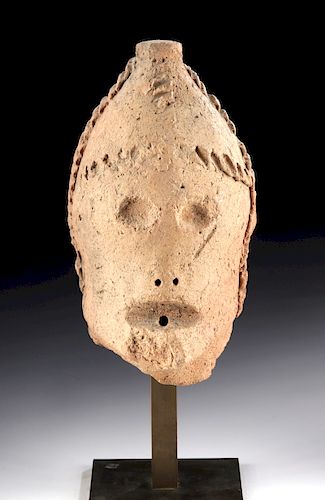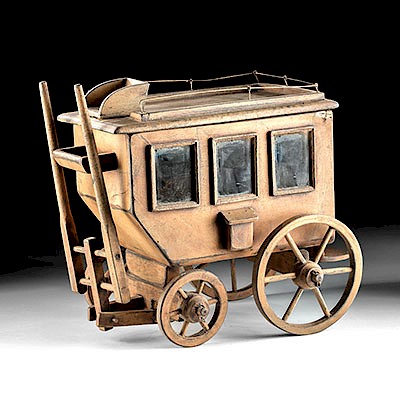14th C. African Koma Terracotta Janiform Head
Lot 115a
About Seller
Artemis Gallery
686 S Taylor Ave, Ste 106
Louisville, CO 80027
United States
Selling antiquities, ancient and ethnographic art online since 1993, Artemis Gallery specializes in Classical Antiquities (Egyptian, Greek, Roman, Near Eastern), Asian, Pre-Columbian, African / Tribal / Oceanographic art. Our extensive inventory includes pottery, stone, metal, wood, glass and textil...Read more
Estimate:
$2,500 - $3,500
Absentee vs Live bid
Two ways to bid:
- Leave a max absentee bid and the platform will bid on your behalf up to your maximum bid during the live auction.
- Bid live during the auction and your bids will be submitted real-time to the auctioneer.
Bid Increments
| Price | Bid Increment |
|---|---|
| $0 | $25 |
| $300 | $50 |
| $1,000 | $100 |
| $2,000 | $250 |
| $5,000 | $500 |
| $10,000 | $1,000 |
| $20,000 | $2,500 |
| $50,000 | $5,000 |
| $100,000 | $10,000 |
| $200,000 | $20,000 |
About Auction
By Artemis Gallery
Nov 14, 2019
Set Reminder
2019-11-14 10:00:00
2019-11-14 10:00:00
America/New_York
Bidsquare
Bidsquare : Ethnographic | Tribal | American Frontier
https://www.bidsquare.com/auctions/artemis-gallery/ethnographic-tribal-american-frontier-4634
Featuring Pre-Columbian, Tribal / Oceanic, Spanish Colonial, historical examples from the Spanish, Mexican, and American frontiers, fossils, and more. All items offered for sale have been legally acquired, are legal to sell and are guaranteed to be as described or your money back. Artemis Gallery info@artemisgallery.com
Featuring Pre-Columbian, Tribal / Oceanic, Spanish Colonial, historical examples from the Spanish, Mexican, and American frontiers, fossils, and more. All items offered for sale have been legally acquired, are legal to sell and are guaranteed to be as described or your money back. Artemis Gallery info@artemisgallery.com
- Lot Description
Ancient West Africa, northern Ghana, Komaland, Koma culture, ca. 14th to 16th century CE. An intriguing, hand-built head of a janiform presentation with a thick neck base, a pair of abstract anthropomorphic faces, striated grooves delineating both faces, and smooth foreheads that taper into a mutual conical top. Each expressive countenance presents with a pair of impressed eyes, a slightly bulging nose with perforated nostrils, and a gaping mouth, with one bearing petite ears, and the other only recessed ear drums. An appealing example of ancient Komaland artistry! Size: 4.5" W x 7.5" H (11.4 cm x 19 cm); 10.8" H (27.4 cm) on included custom stand.
Koma figures were first discovered in the 1980s during archaeological fieldwork directed by Professor Ben Kankpeyeng (University of Ghana). Created by a previously little-understood people in what is known as Koma Land, the figures are often fragmentary. Although there is a paucity of literature on how such figurines were used, scholars have suggested they were used in special ceremonies and rituals in which the spirits of the ancestors were invoked.
Provenance: private New York, New York, USA collection, acquired in 1989; ex-Galerie Pierre Robin, Paris, France
All items legal to buy/sell under U.S. Statute covering cultural patrimony Code 2600, CHAPTER 14, and are guaranteed to be as described or your money back.
A Certificate of Authenticity will accompany all winning bids.
We ship worldwide and handle all shipping in-house for your convenience.
#150359This is a fragment of a larger terracotta sculpture. Losses to jaw of one face as well as areas of neckline as shown. Abrasions and nicks to neckline, both faces, and top, with softening to some finer details, and light encrustations. Nice earthen deposits throughout.Condition
- Shipping Info
-
All shipping is handled in-house for your convenience. Your invoice from Artemis Gallery will include shipping calculation instructions. If in doubt, please inquire BEFORE bidding for estimated shipping costs for individual items.
-
- Buyer's Premium



 EUR
EUR CAD
CAD AUD
AUD GBP
GBP MXN
MXN HKD
HKD CNY
CNY MYR
MYR SEK
SEK SGD
SGD CHF
CHF THB
THB














